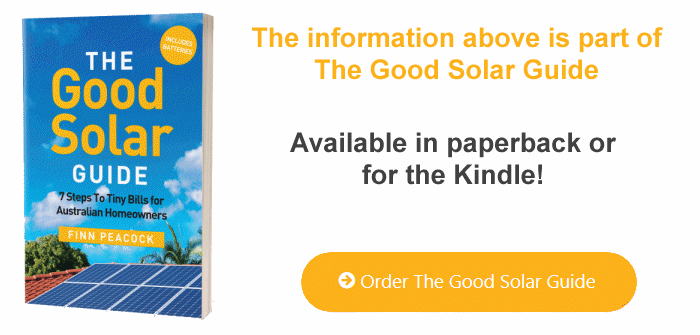Fundamental 6: The high cost of cheap solar
← Roof Angle & Shade | The Good Solar Guide Contents | Know Your Rights →
You bought this book, or are reading it online for free, because you want to make a smart investment in solar power. The first part of buying smart is not to pay too much. The second part of buying smart is to not pay so little that you get a system where corners have been cut and it doesn’t do the job.
I’m defining ‘do the job’ as: generate lots of reliable energy that will give you low bills for decades.
The main principle to bear in mind when buying solar is that the best deal is not the cheapest deal. In Australia, there are large companies operating at the bottom of the market, whose only ‘unique selling point’ is that they’re cheaper than everyone else. With solar, there are simple ways to be cheaper than everyone else:
- Source the cheapest solar panels
- Source the cheapest inverters
- Pay peanuts for the install – ideally with low-paid fulltime employees, or in busy times with the cheapest subcontractors you can find
Really cheap solar panels are highly unlikely to last more than three to five years. Ditto inverters. A really cheap and rushed installation will look ugly, under-perform, fail prematurely, be dangerous – or all four.
To keep their marketing costs low, these companies need to maximise the effectiveness of their marketing. They can achieve this through advertising that
- promises unachievable returns through misleading assumptions about inflation of electricity prices and self-consumption
- claims their cheap panels will outperform the best on the market because of some ‘secret sauce’
- claims their cheap inverter will outlast and outperform any other inverter using obscure technical jargon like ‘start-up voltage’ to sound impressive
- claims their solar panels and inverters are ‘engineered’ in a country that’s highly respected in the industry (often Germany), and often using a PO box from that country as the research and design headquarters
Please don’t fall for the allure of one of these cheap systems. Here’s how to avoid this junk:
- Check your panel is one of the low-risk brands listed in Step 5.
- Check your inverter is one of the low-risk brands listed in Step 5.
- Do a quick back-of-the-envelope check of their payback claims (Step 4). If they assume 100% self-consumption, go elsewhere.
- Look at the length of their installation warranty – insist on at least five years. Use a firm that has been going for at least that long to avoid a company that has no intention of being around to fulfil its warranty. Read online reviews of these longstanding companies to see how their installations have fared.
How to make sure you don’t pay too much – or too little
I maintain a web page that shows up-to-date, ballpark pricing for good-quality solar:
Online resource: Up-to-date price ranges for good-quality solar: https://www.solarquotes.com.au/panels/cost/
The first thing I recommend is to check that the quoted prices are in this ballpark.
There are two legitimate reasons you could pay less and still get a reliable system:
- Using a budget inverter – expect to pay up to $600 less per 5 kW than you would for a premium solar inverter.
- Using a high-volume installer that gets a particularly good price on legitimate panels – expect to save up to $400 per 5 kW.
If you live in a metro area, you may pay up to $1,000 less than the ballparks I’ve provided online for a reasonable budget system. But to get there, the company is going to be dependent on installing consistently high volumes to cover their overheads and it will be operating on slim margins. This increases the risk that the company will not be around in the future.
There are three legitimate reasons you could pay more than the standard:
- You have a particularly difficult install (you need scaffolding, panel tilt frames, modifications to your grid connection, or switchboard upgrades).
- You live way out in the bush, so they need to add travel costs.
- You are also getting lots of extras: power-diversion hardware, battery-compatible hybrid inverters, etc.
In my opinion, the best way to protect yourself against paying too much or too little is simply to get three quotes from well-regarded installers. In Step 6, I’ll walk you through that process.
← Roof Angle & Shade | The Good Solar Guide Contents | Know Your Rights →
Questions or feedback about the content on this page? Contact me.
